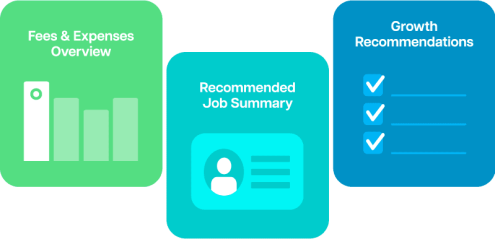UPDATED JULY 2, 2024: It is undoubtedly a tight labour market with businesses worldwide needing to build teams at pace. The demand for global talent has skyrocketed as well as the need for fast and efficient hiring without compromising the quality of the candidates. This is where offshore outsourcing comes in. Offshore outsourcing is when you outsource tasks or an entire role, to a person in another country – hence ‘offshore’. At Staff Domain, we elevate offshore outsourcing with our innovative approach: rapid recruitment.
In this blog, we will delve into what rapid recruitment is, how it works, and why it is your ticket to securing top global talent swiftly and effectively.

Understanding Efficient Hiring Through Rapid Recruitment
At Staff Domain, we understand what it means to hire efficiently. We employ a rapid recruitment strategy to supply your business with the highly skilled manpower you need in little time. We handle identifying, vetting, and testing candidates ahead of your need to hire. This ensures that qualified candidates with the required skills are ready to start when you are. This approach is effective for standard roles such as administration, finance, digital marketing, sales and tech support.
How Efficient Hiring Differs from Staff Domain’s Custom Recruitment?
We offer clients full-time, dedicated staff that supports your company just like your onshore workforce. There are two ways Staff Domain recruits depending on your organisation’s needs:
1 Custom recruitment
Custom recruitment is a campaign built from scratch. It involves attracting new candidates through the full process of screening up to interviews. This is used mostly for clients who have a definite role to fill.
2 Rapid recruitment
Rapid recruitment involves maintaining a pool of candidates who are ready for immediate interviews. This approach is primarily used for clients filling standard roles.
Efficient hiring through rapid recruitment differs from our specific, custom recruitment in one major way:
Speed
We proactively attract and pre-vet candidates before a specific job opening arises. These candidates are already eager to work with us, and have passed four major tests:
Quality candidates are the lifeblood of Staff Domain, regardless of how they are recruited. Our commitment to delivering top-tier talent swiftly and efficiently is underscored by our meticulous candidate selection process
There are various benefits when you choose rapid staffing for your organisation. Some benefits include:
a Unparalleled speed
Efficiency is the name of the game when it comes to rapid staffing solutions. This approach significantly shortens the hiring timeline.
b Abundant talent pool
From outsourced IT services, offshore executive assistants, and virtual admin assistants, rapid staffing leverages an extensive talent pool of 100+ highly skilled candidates across various domains and functions. By leveraging this approach, you can secure the right candidates quickly and effectively, enabling your organisation to thrive in today’s competitive landscape.
Whilst rapid staffing solutions are about quick, efficient hiring, onboarding is something you need to take slowly. The way a new employee is onboarded affects their perception of your company and their role, as well as their productivity from day one.
Here are some critical steps to onboarding your new offshore team member. Staff Domain is there to support you every step of the way.
1 Business processes & systems review
Working with an offshore team is no different to having your onshore team work from home: you need to have internal processes and systems set up. This includes mapping your workflows and moving all business-critical documents and files to the cloud.
2 Tools of the trade
Your new offshore team member will need access to all the tools to do their job. This means you need to provide them with a personal computer, telephone, email address, access to your local servers and systems, software licenses to specific tools, databases, and much more.
3 Onshore team training
Your onshore team needs to understand how your new global team member will work. They need to understand how they will be managed and by who. Hence, training together with the onshore team will expose the global team members on the established.
4 Offshore team training
Preparing for your new team member’s first week is important. Map out an agenda of what their everyday tasks will look like. Fill it with time to read documents you provided, meet key team members, be coached or trained, and more. And of course – a virtual welcome!
5 Meet in person
If you can, fly into Staff Domain South Africa or the Philippines and meet your team in person. This provides an opportunity to build a strong rapport and train them in person. After your recruits have settled in, you should consider bringing them to your country to meet the onshore team and further discover your business in person.
Efficiency is not just a buzzword; it is a competitive advantage. Embrace efficient hiring practices when building your offshore team and take your business to new heights.
Partner with us today and experience the benefits of efficient hiring through rapid recruitment. Staff Domain‘s offshore outsourcing solutions connect your business to a highly experienced global talent pool for game-changing results. Effortlessly manage your offshore workforce with our comprehensive compliance, payroll, and HR support, and benefit from fixed, transparent pricing in your local currency. Contact us today or schedule a meeting with our sales team to quickly source the right offshore team for your business.
FAQs
What strategies can businesses use to attract global talent?
Businesses can attract global talent by offering competitive compensation and benefits packages. Other benefits include promoting workplace diversity and inclusion, allowing for remote work or flexible scheduling, sponsoring work visas or immigration assistance, and showcasing a strong employer brand with a global presence.
What are some common challenges in global recruitment, and how can businesses overcome them?
Language limitations, cultural variations, legal and regulatory compliance concerns, and logistical complexities are among the most typical challenges in global recruitment. Businesses can solve these issues by collaborating with rapid recruitment agencies, doing extensive research, and setting clear communication channels and expectations for all stakeholders.
How can businesses effectively manage remote hiring and distributed teams?
Businesses can effectively manage remote staffing and distributed teams by establishing clear communication channels. Utilising collaboration tools and technology platforms is essential to achieving this. In addition, setting performance expectations and goals helps keep everyone aligned. By cultivating a culture of trust and accountability, employees will feel more confident with their skills and contribute more effectively to the group.
What are some best practices for virtual interviews with global candidates?
Some best practices for conducting virtual interviews with global candidates include testing technology, equipment, and internet connection ahead of time. Other effective strategies for conducting offshore interviews include providing clear instructions beforehand, deciding on a good interview schedule for both parties and developing interview questions that assess both technical skills and cultural fit.
What are some strategies for retaining top global talent once they are hired?
Strategies for retaining highly qualified global talent include various factors. These include offering competitive compensation and growth opportunities, recognising performance, creating a supportive work environment, promoting work-life balance, soliciting feedback, and addressing concerns proactively.
About the Leader

Clara Turner
Global Head of Recruitment
Clara Turner is Staff Domain’s Global Head of Recruitment. With a rich background in end-to-end recruitment and over a decade of experience under her belt, Clara has an excellent track record, specialising in staffing for offshore outsourcing, recruitment process outsourcing (RPO), client, account and team management, and global recruitment across diverse regions including the US, LATAM, Oceania, Asia, and Europe.
Clara has been at the forefront of the recruitment industry, catering to the evolving needs of businesses worldwide. She understands the importance of finding the right talent to drive business success, which is why she leverages a robust network and industry insights to identify top-tier candidates efficiently and effectively.









